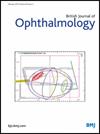Ophthalmic manifestations and treatment outcomes in leukaemia: a comparative analysis of clinical spectrum, visual prognosis and predictors of disease remission across subtypes
IF 3.5
2区 医学
Q1 OPHTHALMOLOGY
引用次数: 0
Abstract
Aim To conduct an analysis of ophthalmic manifestations in leukaemic patients and evaluate their impact on visual outcomes and disease remission. Methods This retrospective, comparative study included 244 patients (378 eyes) diagnosed with leukaemias between January 2016 and 2024. Data included demography, leukaemia type, ophthalmic manifestations, imaging modalities, treatment modalities (ocular and systemic), treatment outcomes (relapses or remission) and final visual acuity. Univariate and multivariate regression analyses were performed to identify correlations and predictive features associated with visual outcomes. Results The mean age of patients was 34.9±22.1 years (range, 1–88 years). Acute lymphocytic leukaemia was the most common subtype (58%), followed by chronic myeloid leukaemia (CML; 20%). Acute forms manifested earlier in life and were more aggressive. The presence of posterior segment manifestations (64%) was more than anterior segment manifestations (52%). Myeloid leukaemia types were more often associated with haemorrhagic manifestations, whereas lymphoid types were associated with non-haemorrhagic manifestations. Univariate regression analysis showed that the presence of epiretinal membrane (OR 0.110, 95% CI 0.012 to 0.951, p=0.04), submacular haemorrhage (OR 0.091, 95% CI 0.010 to 0.763, p=0.027) and type of leukaemia (acute myeloid leukaemia (AML) (OR 3.195, 95% CI 1.697 to 6.012, p<0.000) or CML (OR 6.39, 95% CI 3.130 to 13.041, p<0.000)) had significant association with poor visual outcome. Multivariate regression analysis revealed AML (OR 2.769, 95% CI 1.392 to 5.507, p=0.004) and CML (OR 7.313, 95% CI 3.326 to 16.074, p<0.000) as independent predictors of poor visual outcome. Conclusion Ophthalmic manifestations are major diagnostic and prognostic clues for leukaemias. Pattern recognition facilitates timely recognition, risk stratification, management and disease remission prediction. All data relevant to the study are included in the article or uploaded as supplementary information.白血病的眼科表现和治疗结果:临床谱、视觉预后和不同亚型疾病缓解预测因素的比较分析
目的分析白血病患者的眼部表现,评价其对视力及病情缓解的影响。方法对2016年1月至2024年诊断为白血病的244例患者(378只眼)进行回顾性比较研究。数据包括人口统计学、白血病类型、眼部表现、影像学方式、治疗方式(眼部和全身)、治疗结果(复发或缓解)和最终视力。进行单变量和多变量回归分析,以确定与视觉结果相关的相关性和预测特征。结果患者平均年龄34.9±22.1岁(范围1 ~ 88岁)。急性淋巴细胞白血病是最常见的亚型(58%),其次是慢性髓性白血病(CML; 20%)。急性形式表现在生命早期,更具侵略性。后段表现(64%)多于前段表现(52%)。髓性白血病类型通常与出血表现相关,而淋巴型则与非出血表现相关。单因素回归分析显示,视网膜前膜(OR 0.110, 95% CI 0.012 ~ 0.951, p=0.04)、黄斑下出血(OR 0.091, 95% CI 0.010 ~ 0.763, p=0.027)和白血病类型(急性髓性白血病(AML) (OR 3.195, 95% CI 1.697 ~ 6.012, p<0.000)或CML (OR 6.39, 95% CI 3.130 ~ 13.041, p<0.000))与视力差有显著相关。多因素回归分析显示,AML (OR 2.769, 95% CI 1.392 ~ 5.507, p=0.004)和CML (OR 7.313, 95% CI 3.326 ~ 16.074, p<0.000)是视力差的独立预测因子。结论眼科表现是白血病的主要诊断和预后线索。模式识别有助于及时识别、风险分层、管理和疾病缓解预测。所有与研究相关的数据都包含在文章中或作为补充信息上传。
本文章由计算机程序翻译,如有差异,请以英文原文为准。
求助全文
约1分钟内获得全文
求助全文
来源期刊
CiteScore
10.30
自引率
2.40%
发文量
213
审稿时长
3-6 weeks
期刊介绍:
The British Journal of Ophthalmology (BJO) is an international peer-reviewed journal for ophthalmologists and visual science specialists. BJO publishes clinical investigations, clinical observations, and clinically relevant laboratory investigations related to ophthalmology. It also provides major reviews and also publishes manuscripts covering regional issues in a global context.

 求助内容:
求助内容: 应助结果提醒方式:
应助结果提醒方式:


